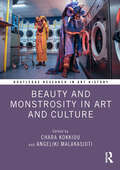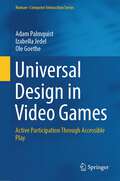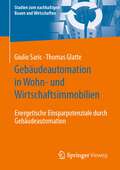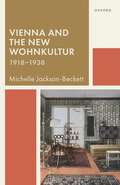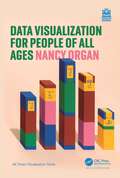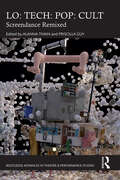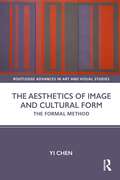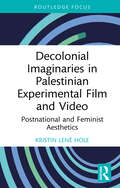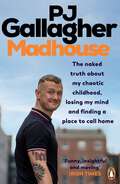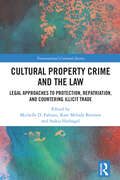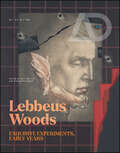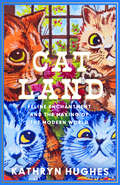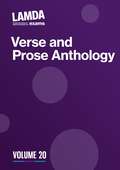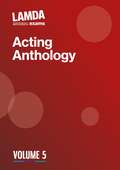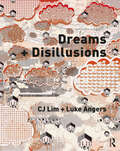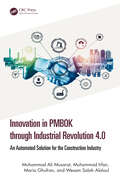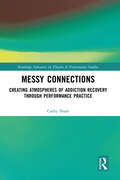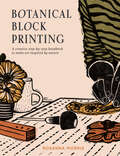- Table View
- List View
Beauty and Monstrosity in Art and Culture (Routledge Research in Art History)
This edited volume takes a new look at an old question: what is the relationship between beauty and monstrosity? How has the notion of beauty transformed through the years and how does it coincide with monstrous ontologies? Contributors offer an interdisciplinary approach to how these two concepts are interlinked and emphasize the ways the beautiful and the monstrous pervade human experience.The two notions are explored through the axis of human transformation, focusing on body, identity, and gender, while questioning both how humans transform their body and space as well as how humans themselves are gradually transformed in different contexts. The pandemic, gender crisis, moral crisis, sociocultural instability, and environmental issues have redefined beauty and the relationship we have with it. Exploring these concepts through the lens of human transformation can yield valuable insights into what it means to be human in a world of constant change.The book will be of interest to scholars working in art history, archaeology, philosophy, architecture, and cultural studies.
Universal Design in Video Games: Active Participation Through Accessible Play (Human–Computer Interaction Series)
by Adam Palmquist Izabella Jedel Ole GoetheAs participation in game related activities increases around the world and across a larger part of the population, it is obvious that games are not just an entertainment medium for children or young people. Games can be used to accomplish different purposes for different groups of people in society. Developing a universal designed game involves more than adding a cast of diverse characters. Games with universal design, at their core, are experiences that are designed from the ground up to be accessible to everyone – through mechanics, options, and user experience. This book explains the meaning and need for universal design in video games and sheds light on important disciplines. Researchers define a universal designed game as a video game that actively welcomes all players. When players connect authentically with a video game, they’re much more likely to engage with the content. Conversely, when players can’t physically play a game, or don’t see characters that look like them, they feel isolated and miss out on beneficial opportunities to learn and collaborate. Universal design maximizes the impact of playing games, for instance, by ensuring that they’re accessible, empowering and representative for every participant.
Gebäudeautomation in Wohn- und Wirtschaftsimmobilien: Energetische Einsparpotenziale durch Gebäudeautomation (Studien zum nachhaltigen Bauen und Wirtschaften)
by Giulio Saric Thomas GlatteMit Gebäudeautomation lassen sich Komfort und Sicherheit eines Gebäudes steigern. Dazu kommt das Potenzial, die Energieeffizienz der Immobilie zu erhöhen, was wirschaftliche Vorteile bei der Bewirtschaftung mit sich bringt. Diese Publikation untersucht verschiedene Smart-Home Technologien im Hinblick auf die Senkung der Energiekosten und vergleicht den ökonomischen Nutzen zwischen Wirtschafts- und Wohnimmobilien. Dabei werden die Anwendungsfelder Beleuchtung, Klimatisierung und Beschattung analysiert und bewertet.
Vienna and the New Wohnkultur, 1918-1938
by Michelle Jackson-BeckettWhile the domestic sphere might seem tangential to the dire political situation and humanitarian crises of interwar Europe, it was nevertheless at the forefront of debates about cultural identity and economic policy in the Viennese press, culture, and arts. Vienna and the New Wohnkultur, 1918-1938 explores why and how the Viennese design landscape was set apart--aesthetically and theoretically--from other European explorations of modern design. Jackson-Beckett examines interior design exhibitions, press, and debates about modern living in interwar Vienna, an overlooked area of modern European architecture and design history, arguing for a reconsideration of the contours of European modernism. The text analyses varied interpretations of modern domestic culture (Wohnkultur) in Vienna, and explores why these interpretations were distinct from other strands of European modernism. Vienna and the New Wohnkultur introduces new research and translation of primary sources on flexible, adaptable, and affordable design by architects, designers, and retailers. Vienna's design discourse also prefigured important postmodern and contemporary discussions on historicism, eclecticism, empathy, and user experience. Through extensive new research in archival and period sources, Jackson-Beckett illustrates how design ideas, taste, and portrayals of domestic culture of fin-de-si?cle Viennese Modernism (Wiener Moderne) were also deployed as forms of cultural and national identity both during the early years of the Social Democratic government in Vienna (1918-1934) and later under the fascist state (1934-1938).
Data Visualization for People of All Ages (ISSN)
by Nancy OrganData visualization is the art and science of making information visible. On paper and in our imaginations, it’s a language of shapes and colors that holds our best ideas and most important questions. As we find ourselves swimming in data of all kinds, visualization can help us to understand, express, and explore the richness of the world around us. No matter your age or background, this book opens the door to new ways of thinking and sharing through the power of data visualization.Data Visualization for People of All Ages is a field guide to visual literacy, born from the author’s personal experience working with world-class scholars, engineers, and scientists. By walking through the different ways of showing data—including color, angle, position, and length—you’ll learn how charts and graphs truly work so that no visualization is ever a mystery or out of reach. It doesn’t stop at what fits on a page, either. You’ll journey into cutting-edge topics like data sonification and data physicalization, using sound and touch to share data across the different senses. Packed with practical examples and exercises to help you connect the dots, this book will teach you how to create and understand data visualizations on your own—all without writing a single line of code or getting tangled up in software.Written with accessibility in mind, this book invites everyone to the table to share the joy of one of today’s most necessary skills. Perfect for home or classroom use, this friendly companion gives people of all ages everything they need to start visualizing with confidence.
Data Visualization for People of All Ages (ISSN)
by Nancy OrganData visualization is the art and science of making information visible. On paper and in our imaginations, it’s a language of shapes and colors that holds our best ideas and most important questions. As we find ourselves swimming in data of all kinds, visualization can help us to understand, express, and explore the richness of the world around us. No matter your age or background, this book opens the door to new ways of thinking and sharing through the power of data visualization.Data Visualization for People of All Ages is a field guide to visual literacy, born from the author’s personal experience working with world-class scholars, engineers, and scientists. By walking through the different ways of showing data—including color, angle, position, and length—you’ll learn how charts and graphs truly work so that no visualization is ever a mystery or out of reach. It doesn’t stop at what fits on a page, either. You’ll journey into cutting-edge topics like data sonification and data physicalization, using sound and touch to share data across the different senses. Packed with practical examples and exercises to help you connect the dots, this book will teach you how to create and understand data visualizations on your own—all without writing a single line of code or getting tangled up in software.Written with accessibility in mind, this book invites everyone to the table to share the joy of one of today’s most necessary skills. Perfect for home or classroom use, this friendly companion gives people of all ages everything they need to start visualizing with confidence.
LO: Screendance Remixed (ISSN)
This edited collection assembles international perspectives from artists, academics, and curators in the field to bring the insights of screendance theory and practice back into conversations with critical methods, at the intersections of popular culture, low-tech media practices, dance, and movement studies, and the minoritarian perspectives of feminism, queer theory, critical race studies and more.This book represents new vectors in screendance studies, featuring contributions by both artists and theoreticians, some of the most established voices in the field as well as the next generation of emerging scholars, artists, and curators. It builds on the foundational cartographies of screendance studies that attempted to sketch out what was particular to this practice. Sampling and reworking established forms of inquiry, artistic practice and spectatorial habits, and suspending and reorienting gestures into minoritarian forms, these conversations consider the affordances of screendance for reimaging the relations of bodies, technologies, and media today.This collection will be of great interest to students and scholars in dance studies, performance studies, cinema and media studies, feminist studies, and cultural studies.
The Aesthetics of Image and Cultural Form: The Formal Method (Routledge Advances in Art and Visual Studies)
by Yi ChenOffering an alternative mode of visual cultural analysis to the prevalent discursive model, this book proposes to situate analysis of Image within ‘formal’ analyses of culture experience.Specifically, the discussion draws on theories of affective aesthetics with the view of addressing the sensual form of culture (i.e. ‘cultural form’). Therefore, the volume puts forward a mode of formalist analysis in visual cultural research which takes purchase on the idea of ‘cultural form’. A continuum of formalist attention between Image analysis (visual media, industrial design) and probing of ‘cultural forms’ establishes the theoretical underpinning of the book. These concepts are expounded through a case study which looks at formal experimentations and debates arising from 1960s avant-garde artistic practices in London.
The Aesthetics of Image and Cultural Form: The Formal Method (Routledge Advances in Art and Visual Studies)
by Yi ChenOffering an alternative mode of visual cultural analysis to the prevalent discursive model, this book proposes to situate analysis of Image within ‘formal’ analyses of culture experience.Specifically, the discussion draws on theories of affective aesthetics with the view of addressing the sensual form of culture (i.e. ‘cultural form’). Therefore, the volume puts forward a mode of formalist analysis in visual cultural research which takes purchase on the idea of ‘cultural form’. A continuum of formalist attention between Image analysis (visual media, industrial design) and probing of ‘cultural forms’ establishes the theoretical underpinning of the book. These concepts are expounded through a case study which looks at formal experimentations and debates arising from 1960s avant-garde artistic practices in London.
Decolonial Imaginaries in Palestinian Experimental Film and Video: Postnational and Feminist Aesthetics (Routledge Focus on Film Studies)
by Kristin Lené HoleDecolonial Imaginaries in Palestinian Experimental Film and Video focuses on an underexamined group of female Palestinian filmmakers, highlighting their relevance for thinking through a diverse set of issues relating to decolonial aesthetics, post-nationalism and gender, non-Western ecologies, trauma and memory, diasporic experiences of space, biopolitics, feminist historiography and decolonial temporalities.Positing that these filmmaker-artists radically counter dominant media images of Palestinians, deessentializing Palestinian identity while opening up history and the present to new potentialities and ways of imagining Palestinian futures, Decolonial Imaginaries in Palestinian Experimental Film and Video argues that Palestinian experience is urgently relevant to all of us. As the works address issues of food availability and land use, environmental collapse and forced displacement, Hole explores how such films generate hope, imagine impossible possibilities and offer inspiration and wisdom when it comes to losing and rebuilding.Addressing a fundamentally transnational and understudied area, this book will resonate with readers working in the areas of film and media studies, Palestinian cultural studies, historiography, Middle East studies and experimental film.
Decolonial Imaginaries in Palestinian Experimental Film and Video: Postnational and Feminist Aesthetics (Routledge Focus on Film Studies)
by Kristin Lené HoleDecolonial Imaginaries in Palestinian Experimental Film and Video focuses on an underexamined group of female Palestinian filmmakers, highlighting their relevance for thinking through a diverse set of issues relating to decolonial aesthetics, post-nationalism and gender, non-Western ecologies, trauma and memory, diasporic experiences of space, biopolitics, feminist historiography and decolonial temporalities.Positing that these filmmaker-artists radically counter dominant media images of Palestinians, deessentializing Palestinian identity while opening up history and the present to new potentialities and ways of imagining Palestinian futures, Decolonial Imaginaries in Palestinian Experimental Film and Video argues that Palestinian experience is urgently relevant to all of us. As the works address issues of food availability and land use, environmental collapse and forced displacement, Hole explores how such films generate hope, imagine impossible possibilities and offer inspiration and wisdom when it comes to losing and rebuilding.Addressing a fundamentally transnational and understudied area, this book will resonate with readers working in the areas of film and media studies, Palestinian cultural studies, historiography, Middle East studies and experimental film.
Madhouse: The naked truth about my chaotic childhood, losing my mind and finding a place to call home
by PJ Gallagher'An absolutely brilliant read' Patrick Kielty, Late Late Show, RTÉ‘Blisteringly honest . . . hilarious, traumatic, joyful and terrifying. Fasten your seatbelts, it’s going to be a bumpy read!’ Liz Nugent'Gloriously unabashed . . . vibrant, poignant and surprisingly hopeful' Irish Times I grew up in a psychiatric experiment crossed with an alcoholic experiment. . . . a place run by two people who were extraordinarily drunk and guarded by a potentially vicious dog with a brain tumour.PJ Gallagher spent much of his childhood knocking back Lucozade with the local alcoholics in his parents' northside pub. But the chaos that reigned for his first ten years was nothing compared to what happened when - having lost the pub - his mum took in six psychiatric patients from the local hospital to give them 'care in the community'.Worst. Idea. Ever.Madhouse is PJ's riotous life story. Covering everything from dogs, motorbikes and the art of small talk, to the lessons of mental breakdown and finally figuring out love, this is PJ unbound. Most surprising - to PJ more than anyone - is the prospect of becoming a dad in his late forties, when he always thought of 'family' as a trap.Madhouse is the funny, insightful and moving story of someone just trying to keep his head above water - and how he is making sense of it all at last!'Terrifically honest, as well as a being funny and sad' Matt Cooper, The Last Word, Today FM 'Delivered in Gallagher’s brilliantly blunt northside brogue, evoking a shade of Roddy Doyle' Irish Independent 'Tells his story with humour and insight making it feel as though you are chatting with an old friend' Irish Examiner'Bold, anarchic . . . relates wild antics and traumas from his tumultuous life with both humour and perceptive clarity' Business Post'So open . . . amazing for understanding and trying to destroy the stigma [of mental health struggles] . . . a great read' Elaine Crowley, Ireland AM, Virgin Media
Cultural Property Crime and the Law: Legal Approaches to Protection, Repatriation, and Countering Illicit Trade (Transnational Criminal Justice)
This book explores innovative approaches to using and operating within and around both criminal law and civil law in the detection, investigation, and restitution of illicit cultural property.The volume brings together a wide range of authors who research and work in combatting cultural property crime. It explores the normative tensions and intersections between civil and criminal law and where they complement each other in the field. It focuses on innovative legal solutions to the unique challenges presented when facing a transnational form of crime that must consider varying structures of law and order, as well as a deep understanding of the heritage in question, both in past and the present cultures. The collection examines what both areas of law contribute to preventing cultural property crime from occurring, holding offenders responsible before the law, and returning objects to their rightful owners and/or places of origin. Combining the perspectives of academics and practitioners, the volume highlights voices from around the globe, using this range of experience to explore new ideas and applications of legal theory and practice to cases involving cultural property crimes.The book will be of interest to academics and practitioners in cultural property crime in the fields of criminology, law, archaeology, museum studies, political science, economics, and law enforcement.
Lebbeus Woods: Exquisite Experiments, Early Years (Architectural Design)
by Aleksandra Wagner Neil SpillerAmerican architect Lebbeus Woods (1940–2012) remains a quiet hero not only among his colleagues, but also for architectural students intrigued by the ideas and fluent beauty of his powerful graphic verve, as well as of his writing. His projects from the mid-1980s until the end of his life have been widely published. However, this AD, in collaboration with the Estate of Lebbeus Woods, explores the earlier period beginning in the late 1960s when Woodswas honing his draughtsmanship and theoretical positions while experimenting with a variety of themes and different modes of expression. When he burst onto the international architectural scene with a solo exhibition and accompanying catalogue (Lebbeus Woods: Origins) at the Architectural Association, London, in 1985, some wondered how anyone could emerge so fully formed, from nowhere. Working against the logic of ‘nowhere’, this issue charts his early trajectory through the largely unpublished drawings and texts, linking them with what came after. Aiming to generate new scholarship, its roster of international interdisciplinary critics and commentators offer a new understanding of Woods’s work and of his formative years, also shining a light on how we might think about the ‘early work’ of any architect’s career. Contributors: Joseph Becker, Aaron Betsky, Peter Cook, Mark Dorrian, Riet Eeckhout, Kevin Erickson, Joerg Gleiter, Sharon Irish, Eliyahu Keller, Lawrence Rinder, Ashley Simone, Ben Sweeting.
Cultural Property Crime and the Law: Legal Approaches to Protection, Repatriation, and Countering Illicit Trade (Transnational Criminal Justice)
by Michelle D. Fabiani Kate Melody Burmon Saskia HufnagelThis book explores innovative approaches to using and operating within and around both criminal law and civil law in the detection, investigation, and restitution of illicit cultural property.The volume brings together a wide range of authors who research and work in combatting cultural property crime. It explores the normative tensions and intersections between civil and criminal law and where they complement each other in the field. It focuses on innovative legal solutions to the unique challenges presented when facing a transnational form of crime that must consider varying structures of law and order, as well as a deep understanding of the heritage in question, both in past and the present cultures. The collection examines what both areas of law contribute to preventing cultural property crime from occurring, holding offenders responsible before the law, and returning objects to their rightful owners and/or places of origin. Combining the perspectives of academics and practitioners, the volume highlights voices from around the globe, using this range of experience to explore new ideas and applications of legal theory and practice to cases involving cultural property crimes.The book will be of interest to academics and practitioners in cultural property crime in the fields of criminology, law, archaeology, museum studies, political science, economics, and law enforcement.
Catland: Feline Enchantment and the Making of the Modern World
by null Kathryn Hughes'Remarkable' Literary Review 'Startlingly original' Amanda Foreman Some called it a craze. To others it was a cult. Join prize-winning historian Kathryn Hughes to discover how Britain fell in love with cats and ushered in a new era. ‘He invented a whole cat world’ declared H. G. Wells of Louis Wain, the Edwardian artist whose anthropomorphic kittens made him a household name. His drawings were irresistible but Catland was more than the creation of one eccentric imagination. It was an attitude – a way of being in society while discreetly refusing to follow its rules. As cat capitalism boomed in the spectacular Edwardian age, prized animals changed hands for hundreds of pounds and a new industry sprung up to cater for their every need. Cats were no longer basement-dwelling pest-controllers, but stylish cultural subversives, more likely to flaunt a magnificent ruff and a pedigree from Persia. Wherever you found old conventions breaking down, there was a cat at the centre of the storm. Whether they were flying aeroplanes, sipping champagne or arguing about politics, Wain’s feline cast offered a sly take on the restless and risky culture of the post-Victorian world. No-one experienced these uncertainties more acutely than Wain himself, confined to a mental asylum while creating his most iconic work. Catland is a fascinating and fabulous unravelling of our obsession with cats, and the man dedicated to chronicling them. 'If a Louis Wain cat were reading this book, he would raise his topper in tribute’ The Times 'Brilliantly researched and unforgettable' Miranda Seymour 'Consistently fascinating … A tremendous literary feat in which we learn about Victorian sociology through the work of a remarkably unique artist' Kirkus, starred review
LAMDA Verse and Prose Anthology: Volume 20
by Lamda ExamsThis anthology presents the set selection of verse and prose pieces for Learners entering LAMDA Graded Examinations in Communication: Speaking Verse and Prose from Entry Level to Grade 8, and LAMDA Introductory Graded Examinations from Stage 1 to Stage 3 (Solo and Group). The collection includes 155 pieces in total: a range of celebrated poems alongside prose extracts from bestselling classic and contemporary novels. It also features original material written specifically for this anthology, including the winner and runners-up of LAMDA Learners' Poetry Prize 2023. Also included is a foreword by Joseph Coelho, Waterstones Children's Laureate 2022–24. For Learners taking LAMDA Examinations, this anthology offers a wide choice of themes, topics and worlds to explore. With many performance possibilities, it is a perfect resource to help Learners practise and develop their communication skills. For the general reader, it is the ideal starting point for discovering contemporary poets and novelists, such as Maya Angelou, Malorie Blackman, Sally Rooney and Michael Rosen, as well as reconnecting with celebrated writers of the past, including Jane Austen, T. S. Eliot and William Wordsworth.
LAMDA Acting Anthology: Volume 5
by Lamda ExamsThis anthology presents the set selection of solo and duologue scenes for Learners entering LAMDA Graded Examinations in Performance: Acting from Grade 1 to Grade 5. The 100 speeches and scenes in this collection include excerpts from published plays and adapted novels, as well as new, original material written specifically for this anthology. There are monologues for solo performance and duologue scenes for two performers, all carefully curated to offer a broad range of material written by a variety of acclaimed playwrights, from Euripides, Shakespeare and Ibsen to Caryl Churchill, Chinonyerem Odimba and Jack Thorne. Also included is a foreword by actor and LAMDA graduate Ruth Wilson. For Learners taking LAMDA Examinations, this anthology offers a wide choice of characters and worlds to explore. There is material for younger candidates who are just entering the world of performance, as well as material for older, more experienced actors. For the general reader, this anthology is an ideal starting point for discovering the work of contemporary playwrights, as well as reconnecting with celebrated writers of the past.
Dreams + Disillusions
by CJ Lim Luke AngersDreams + Disillusions explores the plethora of ideas and ideologies that have shaped and reshaped cities in profound ways. However, unlike a conventional title on the history of urbanism and architecture, its research fluctuates between the world of concrete reality and the multiple universes that exist in lucid prose, poetic visions, and the outrageous imaginations of history’s greatest and most (in)famous minds. In their thoughts are the foundations for political trends and new civilisations, alternative mappings and unlikely phenomena. The six chapters reveal dreams that were fundamental to the origin of great cities, underpinning the stories of the many lives within; and how, through circumstance or manipulation, fortunate coincidence or planned perfection, desires are sometimes left defeated and disillusioned.Myth and belief. Tradition and logic. Revolution and marginalisation. Ignorance and hubris. Sins and excess. Seasons and climate. Continuously interacting, shifting to enlighten and to enrage, these themes combine critical thinking with deep-rooted influences and new agencies that are a true sign of the times. The 18 illustrated speculations provide an abundance of curious imaginings, diverse provocations and satirical criticism. While there are distinctions between dreams and disillusions, could virtues be made of sins, or sensitivity be borne from hubris? Could progress advocate tradition, or should we re-attempt revolutions formerly experienced as disillusionments? Whether by bold gestures or by subtle attrition, cities are continually re-written crucibles for the human condition. In this book, we develop a better understanding of the discourse of cities tailored to the determining factors of climate, resources, and humanity’s idiosyncrasies to address a world in crisis.
Dreams + Disillusions
by CJ Lim Luke AngersDreams + Disillusions explores the plethora of ideas and ideologies that have shaped and reshaped cities in profound ways. However, unlike a conventional title on the history of urbanism and architecture, its research fluctuates between the world of concrete reality and the multiple universes that exist in lucid prose, poetic visions, and the outrageous imaginations of history’s greatest and most (in)famous minds. In their thoughts are the foundations for political trends and new civilisations, alternative mappings and unlikely phenomena. The six chapters reveal dreams that were fundamental to the origin of great cities, underpinning the stories of the many lives within; and how, through circumstance or manipulation, fortunate coincidence or planned perfection, desires are sometimes left defeated and disillusioned.Myth and belief. Tradition and logic. Revolution and marginalisation. Ignorance and hubris. Sins and excess. Seasons and climate. Continuously interacting, shifting to enlighten and to enrage, these themes combine critical thinking with deep-rooted influences and new agencies that are a true sign of the times. The 18 illustrated speculations provide an abundance of curious imaginings, diverse provocations and satirical criticism. While there are distinctions between dreams and disillusions, could virtues be made of sins, or sensitivity be borne from hubris? Could progress advocate tradition, or should we re-attempt revolutions formerly experienced as disillusionments? Whether by bold gestures or by subtle attrition, cities are continually re-written crucibles for the human condition. In this book, we develop a better understanding of the discourse of cities tailored to the determining factors of climate, resources, and humanity’s idiosyncrasies to address a world in crisis.
Innovation in PMBOK through Industrial Revolution 4.0: An Automated Solution for the Construction Industry
by Muhammad Musarat Muhammad Irfan Maria Ghufran Wesam Salah AlaloulIn this textbook for upper-undergraduate and postgraduate students, Dr Ali and colleagues provide the reader with information on the effect of Industrial Revolution 4.0 on the construction industry, particularly regarding PMBOK knowledge areas.The authors furnish readers with an understanding of IR 4.0 and reasons for adopting it and provide an in-depth insight into the impact of IR 4.0 on technology and society, particularly in the construction industry. Further to this, they also compare traditional and IR 4.0 project manager’s competencies so that readers can develop their understanding of Project Management Knowledge areas and how IR 4.0 can be used to enhance these knowledge areas. The book is structured logically and sequentially to benefit even novice readers as they progress from basic to more advanced topics related to IR 4.0 and PMBOK. The final main chapter of this book provides an in-depth discussion of the enhancement of PMBOK knowledge areas using IR 4.0, including topics such as project integration management, IR 4.0 enhancements such as digitalization, and a conceptual framework for industry betterment. By the end of the book, readers will have the knowledge and skills to apply IR 4.0 techniques in their future careers in the construction industry.This book is an invaluable resource for students of construction engineering and management at upper-undergraduate and postgraduate levels and for existing industry professionals as part of their continuous professional development.
Innovation in PMBOK through Industrial Revolution 4.0: An Automated Solution for the Construction Industry
by Muhammad Musarat Muhammad Irfan Maria Ghufran Wesam Salah AlaloulIn this textbook for upper-undergraduate and postgraduate students, Dr Ali and colleagues provide the reader with information on the effect of Industrial Revolution 4.0 on the construction industry, particularly regarding PMBOK knowledge areas.The authors furnish readers with an understanding of IR 4.0 and reasons for adopting it and provide an in-depth insight into the impact of IR 4.0 on technology and society, particularly in the construction industry. Further to this, they also compare traditional and IR 4.0 project manager’s competencies so that readers can develop their understanding of Project Management Knowledge areas and how IR 4.0 can be used to enhance these knowledge areas. The book is structured logically and sequentially to benefit even novice readers as they progress from basic to more advanced topics related to IR 4.0 and PMBOK. The final main chapter of this book provides an in-depth discussion of the enhancement of PMBOK knowledge areas using IR 4.0, including topics such as project integration management, IR 4.0 enhancements such as digitalization, and a conceptual framework for industry betterment. By the end of the book, readers will have the knowledge and skills to apply IR 4.0 techniques in their future careers in the construction industry.This book is an invaluable resource for students of construction engineering and management at upper-undergraduate and postgraduate levels and for existing industry professionals as part of their continuous professional development.
Messy Connections: Creating Atmospheres of Addiction Recovery Through Performance Practice (ISSN)
by Cathy SloanThis book examines performance practices that involve people in recovery from addiction, theorising such practices as recovery-engaged.Focusing on examples of practice from a growing movement of UK-based recovery arts practitioners and performers, it highlights a unique approach to performance that infuses an understanding of lived experiences of addiction and recovery with creative practice. It offers a philosophy of being in recovery that understands lived experience, and performance practice, as a dynamic system of interrelations with the human and nonhuman elements that make up the societal settings in which recovery communities struggle to exist. It thereby frames the process of recovery, and recovery-engaged performance, as an affective ecology – a system of messy connections. Building upon ideas from posthumanist research on addiction, cultural theory on identity and new materialist interpretations of performance practice, it considers how such contemporary theory might offer additional ways of thinking and doing arts practice with people affected by addiction. The discussion highlights the distinct aesthetics, ethics and politics of this area of performance practice.This study will be of great interest to students and scholars in Applied Theatre and Critical Arts and Mental Health studies.
Messy Connections: Creating Atmospheres of Addiction Recovery Through Performance Practice (ISSN)
by Cathy SloanThis book examines performance practices that involve people in recovery from addiction, theorising such practices as recovery-engaged.Focusing on examples of practice from a growing movement of UK-based recovery arts practitioners and performers, it highlights a unique approach to performance that infuses an understanding of lived experiences of addiction and recovery with creative practice. It offers a philosophy of being in recovery that understands lived experience, and performance practice, as a dynamic system of interrelations with the human and nonhuman elements that make up the societal settings in which recovery communities struggle to exist. It thereby frames the process of recovery, and recovery-engaged performance, as an affective ecology – a system of messy connections. Building upon ideas from posthumanist research on addiction, cultural theory on identity and new materialist interpretations of performance practice, it considers how such contemporary theory might offer additional ways of thinking and doing arts practice with people affected by addiction. The discussion highlights the distinct aesthetics, ethics and politics of this area of performance practice.This study will be of great interest to students and scholars in Applied Theatre and Critical Arts and Mental Health studies.
Botanical Block Printing: A Creative Step-by-step Handbook To Make Art Inspired By Nature
by Rosanna MorrisDiscover the world of botanical block printing through an approachable guide that unveils a plethora of practical techniques and processes. This guide invites you to create stunning prints inspired by the natural world, all crafted by your own hands.
